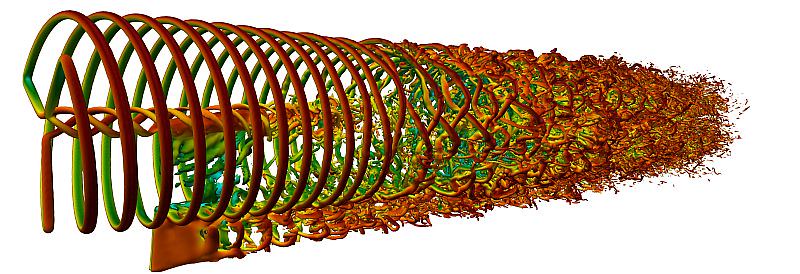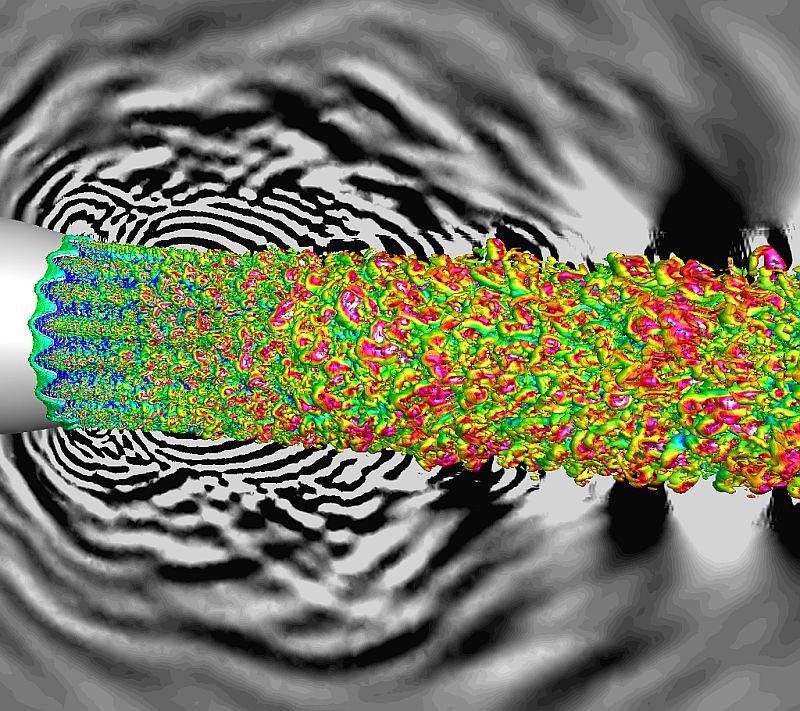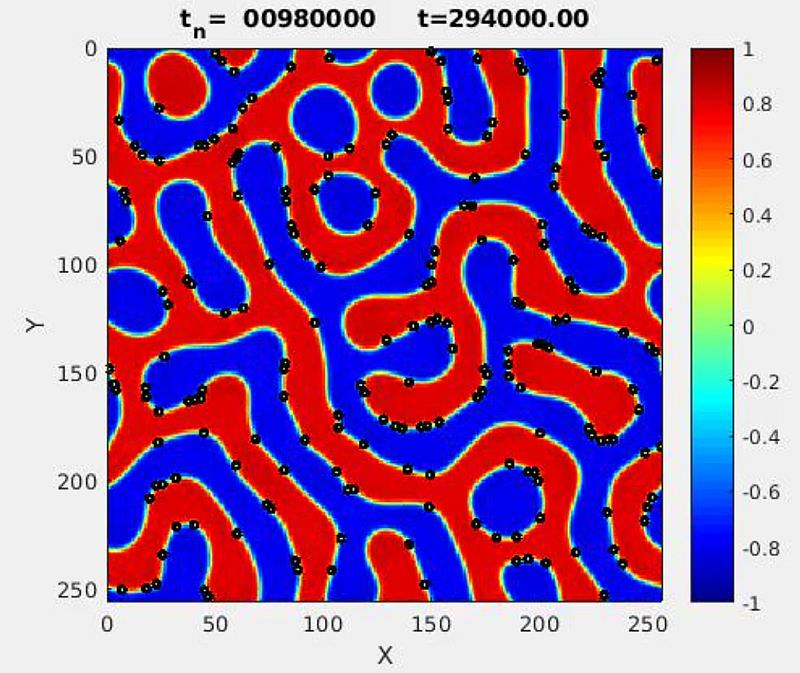1. Atom-by Atom attrition wear of diamond (carbon atom) while scratching pure iron
Dr Saurav Goel, Ultra-Precision Engineering, Cranfield University
Despite fifty years of efforts, the scientific community has not yet found a convincing explanation for the wear mechanism of diamond during ultra-precision machining of low carbon ferrous alloys or pure iron (a very soft metal). The answer to the wear problem will pave way to low-cost manufacturing of high-precision moulds required by handheld gadgets and many other precision applications. This video provides a first direct evidence with high fidelity on the wear of the diamond tool (blue atoms) while scratching pure iron (grey atoms). The time dependent wear of diamond is seen to occur at a timestep of (289900) where one small atom (red colour) experience unbearable strain an is pulled from diamond. The new findings came from molecular dynamics simulation on ARCHER using long range screening bond order potential function fully parametrised both for iron and carbon thus highlight importance of simulations in practical engineering applications.

2. A human lyzozyme molecule attached by a giant polymeric squid.
Dr Danilo Roccatano, University of Lincoln, School of Mathematics and Physics
The developing of novel nanocarriers for drug delivery could help to overcome the current limitation of traditional medicines with potential social and economic impacts. Polymeric micelles, such as the versatile polyether-based block copolymers, are promising nanocarrier that can improve the transport of otherwise easily degradable therapeutic proteins in the human body. However, despite a large number of experimental studies, detailed molecular descriptions of absorption and release processes of proteins by this type of micelles are still very limited. Molecular modeling is a powerful tool to obtain detailed molecular insights into these phenomena that can help to improve the design of these nanocarriers. The image shows the protein lysozyme embraced by the protruding Pluronic P85 chains of a small micelle. The image was the result of Molecular Dynamics Simulation (MDS) exploration lasted 400 ns and carried out with the class Gromacs2016 nano-submarine MDS Nautilus powered by the ARCHER engine.

3. Spatiotemporally Coupled Laser Pulse Compression
Mr Thomas Wilson, University of Strathclyde, Physics Department
The manipulation of intense lasers can be challenging. Solid optic equipment can be damaged, and shaping pulses to particular profiles can be expensive. However, plasmas offer many options to shape and manipulate high power lasers, having highly tunable optical properties and no damage threshold.
This image shows the results of a 3D particle-in-cell simulation of a spatiotemporally coupled laser pulse compression. The 3D rendered surfaces show snapshots of the laser pulse, coloured according to the amplitude.
The lower plane shows the intensity distribution through each snapshot, and the rear plane shows the plasma electron density at the the final snapshot.
The pulse is compressed uniformly in all directions down to only a single wavelength, accompanied by a huge increase in intensity, over 150 times the initial. Further attempts to compress the pulse cause it to collapse. However, the pulse remnant re-emerges from the collapse site, and even undergoes further collapses.

4. Rectangular nanoparticles in a diblock copolymer mixture.
Mr Javier Diaz, University of Lincoln, School of Mathematics and Physics
Rectangular colloids are dispersed into a mixture of diblock copolymers, which is a chain-like molecule in which two species - A and B monomers - are joined together. For this reason, a periodic ordered structure is observed. In this simulation performed in ARCHER, rectangular particles have an affinity towards the interface between the blue and yellow phase. Because the total length of the nanoparticles is larger than the interface present in the system, the colloids drive the system into creating smaller domains, forming the grid-like structure that is found in this simulation. The rectangular nanoparticles 'fit' into the interface by orienting along the it, which is a characteristic of anisotropic particles that would not be present in circular particles.

5. Spherical nanoparticles in an asymmetrical diblock copolymer
Javier Diaz, University of Lincoln, School of Mathematics and Physics
Spherical nanoparticles (red) are dispersed in a diblock copolymer mixture. In the absence of particles, a diblock copolymer can phase separate into ordered alternating phases with a periodicity. This makes copolymers a perfect matrix to assembly colloid. Here, the red colloids have an affinity towards the interior of the domains.
6. Circular nanoparticles segregating to the interface between lamellar diblock copolymer domains.
Javier Diaz, University of Lincoln, School of Mathematics and Physics
Colloidal nanoparticles can be mixed with diblock copolymers to produce highly ordered polymer nanocomposite materials. This video shows a simulation of a low concentration of colloids that segregate to the interface between a symmetrical lamella-forming diblock copolymer. The result of this co-assembly is a system with highly localized colloids.

7. Turbulence-resolving simulation of the wake behind two in-line wind turbines
* * * Winning Image entry * * *
Georgios Deskos, Department of Aeronautics, Imperial College London
Vortical structures generated in the wake of two in-line wind turbines with an incoming velocity of 10 m/s. The simulation was performed on ARCHER using the high-order finite-difference flow framework Winc3d/Incompact3d. The wind turbines are modelled using an actuator line model. Photos are not enhanced.

8. Protein clustering on a neuron surface
William Glass, University of Oxford, Department of Biochemistry
In order for excitable cells to function correctly certain proteins (called ion channels) are critical to allow charged ions to pass across the membrane. The image shows a certain type of ion channel (a voltage-gated sodium channel, blue) that has recently been shown to cluster with other proteins called beta 3 subunits (shown in green). Although it has been shown previously that these proteins interact we have yet to have a clear picture of just what this interaction is and how it can affect the density, location and function of the ion channel. In order to investigate this computationally we used large scale coarse-grained simulations (where 4 'heavy' atoms are represented by 1 'bead'). We constructed a membrane using lipids that are typically found in mammalian cells, with 9 copies of the ion channel and 36 copies of the smaller beta 3 subunit. This system was run for 20 microseconds.

9. Heroes come in all shapes and sizes, but which cobalt nanoparticles exactly are the best for biomedical applications?
Barbara Farkas, School of Chemistry, Cardiff University
Magnetic nanoparticles continue to improve the efficiency of numerous biomedical techniques as visualization agents in MRI, therapeutic vehicles in drug delivery and heat mediators in hyperthermia. However, with the long-lasting clinical testing and so many different options on the table, there is a big chance of missing some of the promising materials. Recent advances in theoretical modelling and available supercomputing power have greatly contributed to the design of magnetic nanoparticles with multifunctional capabilities, which enhanced their applications in the biomedicine.
This image represents a challenge of finding the best match of the nanoparticle's type, shape, and size with combinations reaching a large number - in the order of hundreds - only for single-element metallic materials. ARCHER made it possible to test cobalt nanoparticles as potentially promising candidates for hyperthermia treatments progressing from small non-crystalline clusters to a series of different crystalline motifs of up to 1500 atoms per nanoparticle.

10. A Nanoparticle Walks into a Tumour (and Other Biomedical Challenges): Towards a Morphology, Size, and Shape of Perfect Anti-Cancer Agents
Barbara Farkas, School of Chemistry, Cardiff University
Nanotechnology has revolutionised cancer treatment in the last decade due to the unique properties packed in the nanosized features. Small sizes that are at the very limit of invisible, however, brought big challenges to experimentalists. The ability to investigate substances at the atomic level using supercomputers as ARCHER has boosted both the analysis of compounds that were expected to perform good as well as the search for new materials with outstanding properties for use in the biomedicine.
This image shows the journey that starts with a cobalt nanoparticle, made of highly magnetic but toxic metal and as such would never be considered a good candidate for the cancer therapy, carries on with its modification with gold coating and functionalisation with biomolecules, just to terminate with a multimodal nanocomposite that has both biocompatibility and power to fight the malignant disease. And all of that thanks to the almighty engine of ARCHER machines.

11. Artistic representation of an atom-by-atom building process of 3D nanostructures using purely the mechanical forces of an atomic force microscope (AFM) and atomically sharp tips. The material is GaAs.
David Abbasi Perez, King's College London, Department of Physics
This is an artistic representation that shows an oscillating atomically sharp tip capable of picking and dropping vertically either gallium or arsenic atoms indistinctly in a reversible way in order to build 3D nanorods, using purely mechanical forces. This tip could be seen as an atomic crane, which ultimate objective will be create 3D nanostructures on a GaAs surface. The tip, at the top right part of the image, is an oscillating atomic force microscopy tip, and the vertical columns are the hypothetical nanorods we would like to build, if possible. Calculations run on Archer so far have shown that the reversible picking and deposition process of single atoms using purely mechanical forces is possible. The image has been generated using mainly Blender and The Gimp open software codes.
12. Schematic representation of an atom-by-atom building process of nanostructures using purely mechanical forces of an atomic force microscope (AFM) and atomically sharp tips.
David Abbasi Perez, King's College London, Department of Physics
This little cartoon represents a complicated mechanism in which a crane-like device is capable of pick up and deposit one adsorbed atom at a time on the surface and repeat this process many times in order to build 3D nanostructures. This full picking-deposition cycle is key in order to build 3D nanostructures on an atom-by-atom basis using purely mechanical forces of an atomic force microscopy (AFM). This is known as mechanochemistry. The atomic crane is an atomic force microscopy oscillating tip and the material is GaAs. Although extremely difficult from an experimental point of view, simulations run on Archer show that this process is in principle possible. The animation has been created frame-by-frame using the open source code Krita.
13. Hypersaline sea surface release and propagation under tidal conditions in the northern North Sea
* * * Winning Video entry * * *
Pierre Cazenave, Plymouth Marine Laboratory, Marine Ecosystem Modelling and Prediction
A hypersaline point source is set up within an FVCOM model of a region in the northern North Sea. The very salty water is denser than its surroundings and so plummets to the sea bed in a single narrow column. Once at the bottom of the sea, the tides moves and mixes the salty water making it spread around the seabed, until it is mixed to the point it is indistinguishable from the rest of the water in the North Sea.

14. Spiral vortices in photoelectron momentum distributions
Gregory Armstrong, Centre for Theoretical Atomic, Molecular and Optical Physics, Queen's University Belfast
The image shows the photoelectron momentum distribution obtained following irradiation of the potassium atom by two counter-rotating circularly-polarized infrared laser pulses. Such pulses induce interference between photoelectron wavepackets which is manifest in the form of spiral vortices in the momentum distribution. Here the inner spiral feature arises from the absorption of three photons from each of the two laser pulses. The opposing helicity of these pulses creates a six-arm spiral interference pattern. The outer spiral feature is the signature of an additional photon absorption from each pulse, resulting in an eight-arm spiral vortex.
The calculations were performed on ARCHER using the R-matrix with time-dependence (RMT) codes, which treat interactions between multi-electron atoms and molecules with laser fields of arbitrary polarization.

15. Turbulence-Generated Noise from a Serrated Nozzle Jet
* * * Winning Early Career Researcher and overall competition winning entry * * *
Zhong-Nan Wang, Department of Engineering, University of Cambridge
This image shows the broadband noise generated by a turbulent jet from serrated nozzle. The nozzle serration is used to break up turbulent structures into small scales for noise reduction. The q-criterion shows the turbulent structures and background grey-scale contours shows emitted acoustic waves. Multi-scale phenomena can be seen from perspectives of both turbulence and acoustics. Acoustic waves are generated at different locations in the near field and interfere as propagating to the far field.




